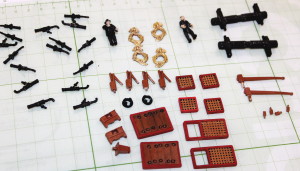In September, I delayed working on the Bonhomme Richard to build a model of Sultana for a friend. Now, I have been asked to build a model of the Lake Champlain gunboat, Philadelphia, and to give a lecture at the Quogue Library in March. With another commission pending, work on my ‘great American ship model’ must again be delayed.
Author Archives: edsships
Sultana 10-11-13
Sultana -10/11/13
I have finished sanding and painting the bottoms of the Sultana hulls. The next step is to add the decks and deck fittings. The deck fittings have been painted and are ready to go.
This is where I may need to re-do some items, because I know that the scale from the plans is not correct on some of these fittings. The figureheads have already been attached and will also be painted once I have attached the rails.
Sultana -9/23/13
Sultana – 9/23/13
I am postponing my work on the Bonhomme Richard to build two models of the Sultana, a colonial schoooner that patrolled American waters to enforce British shipping rules. I will keep one model to join my collection.
I typically build plank-on-bulwark or plank-on-frame models. This is my first solid hull model. It’s quicker, but less satisfying to build. At this stage, I have finished sanding the hulls and am applying the keels, stems, and stern posts.
The Sultana plans are very straightforward. I will do some modification, since I am familiar enough with the design to add details that were not included in the plans.
Bonhomme Richard
How do you build a ship model? Research, research, research!
Surprisingly, in spite of the fact that it is one of the most celebrated ships in American history, no one knows what the Bonhomme Richard really looked like. For this reason alone, Howard Chapelle lists it as one of the ships that model-makers should never build.
I don’t agree. To capture a sense of what it must have been like to watch John Paul Jones’ ship sail into battle, I’m willing to go with a well researched and “plausible” design. Twenty-five years ago, Jean Boudriot came up with just such a highly researched and plausible reconstruction of how Bonhomme Richard might have appeared, with beautiful 1:48 scale plans to match.
William Gilkerson, whom I always admired for his scrimshaw, worked with Boudriot to create excitingly vivid pictures of the Bonhomme Richard and the Battle of Flamborough Head.
And then we have those wonderful descriptions of the battle itself, the first and best written by John Paul Jones himself, followed by many retellings, most recently by Evan Thomas.
With my love of American naval history and the Revolutionary War, how could I not want to build this model?
And so I began planning what I know will be a very long commitment. Following the plans, it would have to be a scratch-built plank-on-frame model. But would I build it admiralty style? The frames would be there, why not show them off? But all the decks, down to the hold, would also be there, so why not expose them, too?
Then, I read John Camarata’s Waterline Dioramas, and I realized that I want to build a waterline model of the Bonhomme Richard as she may have looked on the night of September 23, 1779, riding on an eerily calm sea, just moments before she engaged the H.M.S. Serapis …
Bonhomme Richard
Bonhomme Richard
I am building a 1:48 scale waterline diorama of the Bonhomme Richard, the ship that made John Paul Jones famous. When finished, the model will measure about 5 feet long, 1.5 feet wide, and 4 feet high. Each week, I will chart my progress on this web site, from reading the very intricate and beautiful plans (created by Jean Boudriot) to the opening of its first showing.
My goal is to display my Bonhomme Richard by July 4, 2014 in a corporate lobby, museum, government building, or library. The Bonhomme Richard is a scratch-built, plank-on-frame model. As I am building the Bonhomme Richard, I will work on other models and demonstrate the building of solid hull and bulwark-on-frame models.
As you read the posts, remember that the last entry is listed first. To read the posts in chronological order, you must scroll to the end and work your way backwards.










